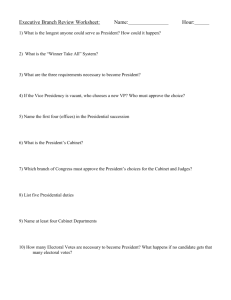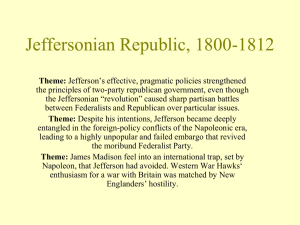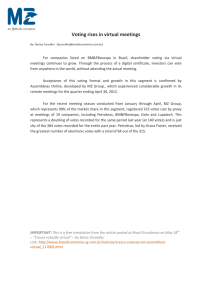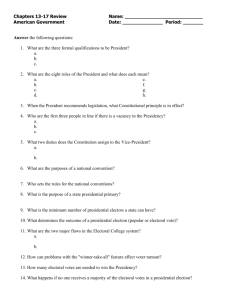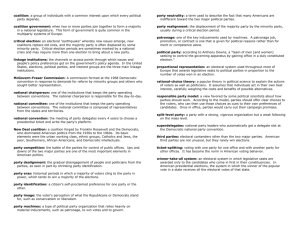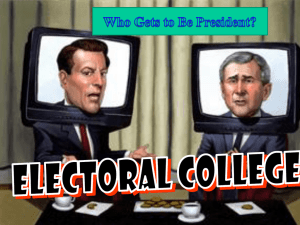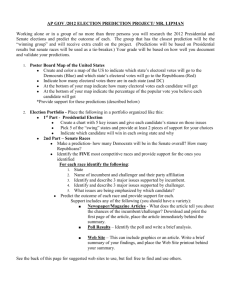Math and politics A look at how math affects elections
advertisement
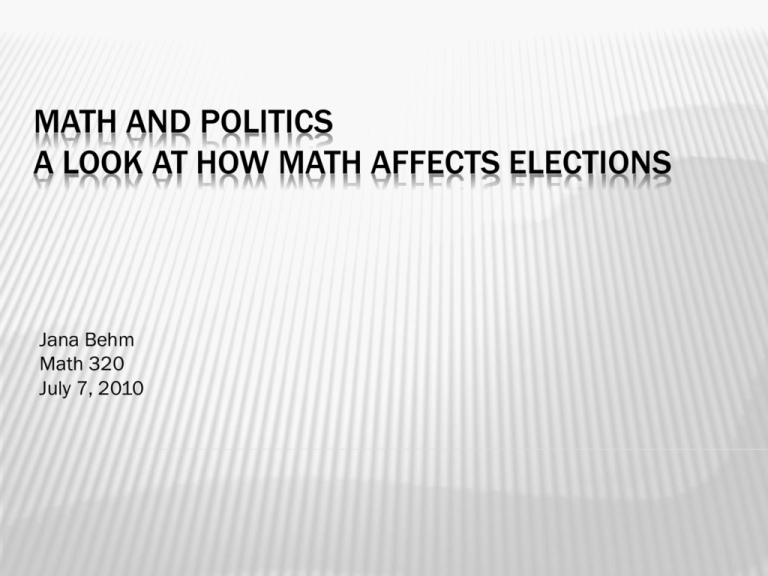
MATH AND POLITICS A LOOK AT HOW MATH AFFECTS ELECTIONS Jana Behm Math 320 July 7, 2010 OVERVIEW Voting Systems and how they can effect outcomes *Majority Rule *Plurality Voting *Electoral College MAJORITY RULE *Straight forward *Excellent for choosing between 2 candidates *Most votes wins *No single vote counts more than any other *Potential problem: TIES (usually broken in some pre-arranged way) *Another potential problem: difficult in a multiparty system PLURALITY VOTING *More than 2 alternatives in an election *Simply count the number of 1st place votes *Possible that no candidate has the majority of the votes cast THE MATH OF MAJORITY AND PLURALITY VOTING *Majority voting: simple majority >Votes cast: 100 with 2 candidates– winner needs a simple majority which is (100/2) +1 or 51 votes to win the election. *Plurality voting: simple math >Votes cast: 100 with 3 candidates – winner simply needs the most votes, not necessarily a majority of the votes cast. THE MATH OF MAJORITY AND PLURALITY VOTING Example: 1992 US Presidential Election Total Votes Clinton Bush 104,425,014 44,909,326 43.01% 39,103,882 37.45% Perot 19,741,657 18.91% Therefore Clinton was the winner, but did not receive the majority of the votes cast Source: http://iun.edu/~mathiho/mathpol/fall00/chapter11.htm U.S. ELECTORAL COLLEGE *Each state is given an electoral numbers which equals the number of US representatives + the 2 senators that they have *How are the representatives divided? *Is this fair? *2009 estimates US population to be 307,006,550 people U.S. ELECTORAL COLLEGE CONTINUED State MT IA IL FL NY TX CA Population 974989 3007856 12910409 18537659 19541453 24782302 36961664 % of US pop 0.32% 0.98% 4.21% 6.04% 6.37% 8.07% 12.04% US Population = 307,006,550 Electoral votes 3 7 21 27 31 34 55 % of electoral votes 0.56% 1.30% 3.90% 5.02% 5.76% 6.32% 10.22% Electoral votes possible: 538 Source for population numbers: http://quickfacts.census.gov/qfd/states/17000.html WINNING AN ELECTION BUT LOSING THE POPULAR VOTE 2000 Presidential Election Candidate Popular Vote George W. Bush 50,460,110 Albert Gore Jr. 51,003,926 % 47.87% 48.38% Electoral Vote 271 266 % 50.4% 49.4% Neither candidate had a simple majority as there were 6 candidates on the ballot. Plurality voting is not in effect in the United States President Bush won 2 large electoral states, but MANY of the smaller states that added up for the electoral win Mr. Gore won largely populated states, but not enough of them for electoral victory. Source: http://www.uselectionatlas.org/RESULTS/national.php?f=0&year=2000 2000 ELECTORAL MAP ELECTORAL MATH There are 538 electoral votes possible Candidates must get a simple majority 538/2 +1 = 270 votes Therefore, they can have a simple majority of electoral votes without having a majority of votes cast in an election or even the most votes cast. LET’S PLAY WITH THE MATH http://www.archives.gov/federalregister/electoral-college/calculator.html http://www.realclearpolitics.com/epolls/maps/ obama_vs_mccain/?map=1 CONCLUSION Does math effect election outcomes? Can one state change the entire course of an election with as little as 3 electoral votes? How many configurations of states will give you the 270 needed to win? Are the big states mandatory, or do they just make it easier?
